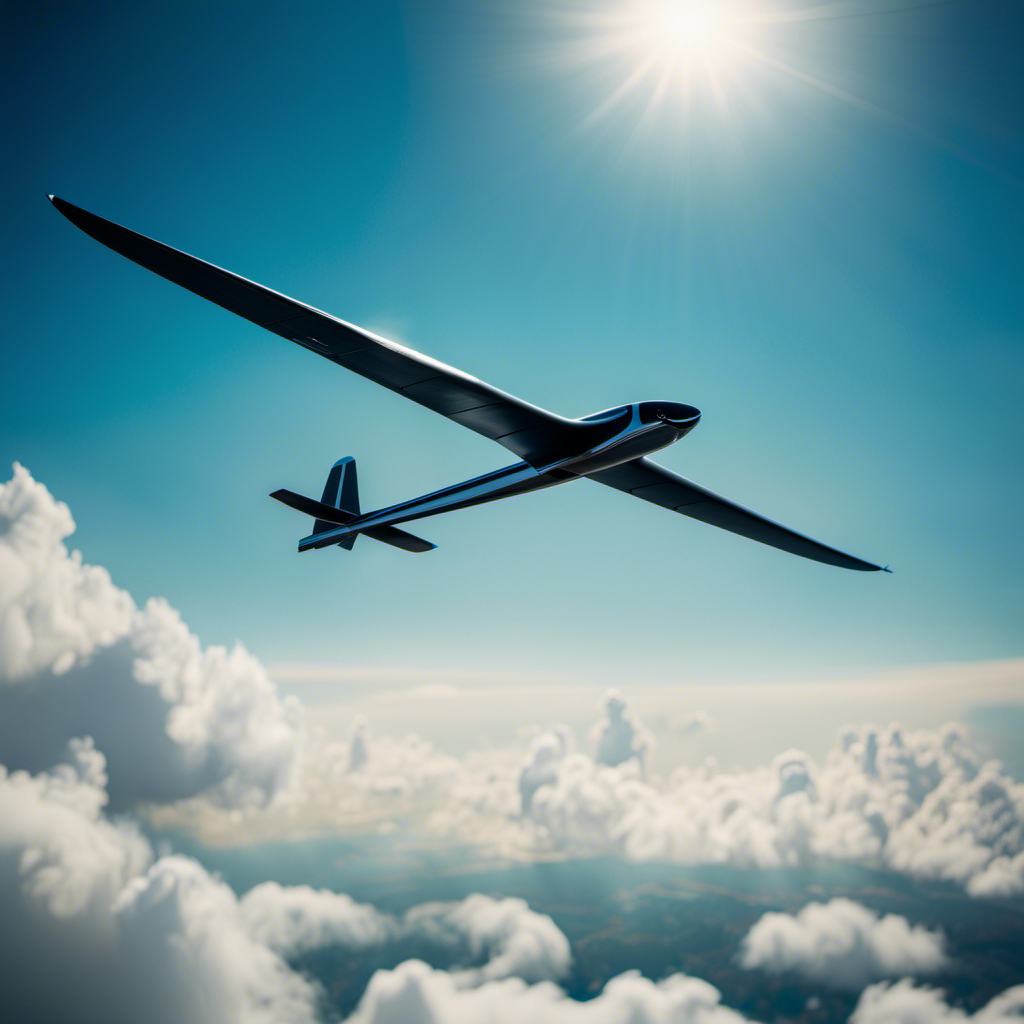As a pilot, I have always been intrigued by the intricate relationship between a sailplane and its tow plane. The tow plane, comparable to a powerful horse, must possess certain qualities to ensure a smooth and safe ascent into the sky.
In this article, we will explore the key factors that make a good sailplane tow plane. From its power and engine performance to its towing capacity and safety features, we will delve into the technical aspects that elevate a tow plane from good to exceptional.
Key Takeaways
- Clear visibility from cockpit with unobstructed view and scratch-resistant, fog-resistant visor
- Reliable radio system for effective communication between tow plane and sailplane
- Prioritizing fuel efficiency and range for maximum flight performance
- Comfortable and well-equipped cockpit with adequate legroom, adjustable seats, and ergonomic controls
Power and Engine Performance
You’ll need an engine with sufficient power and performance to effectively tow a sailplane. When it comes to power efficiency, it’s crucial to have an engine that can generate enough thrust to pull the sailplane through the air. This requires a strong and reliable engine that can handle the additional load. Engine reliability is paramount, as a breakdown during a tow could have serious consequences. It’s important to choose an engine that has a proven track record of reliability and durability.
To ensure power efficiency, it’s also important to consider the engine’s fuel consumption. A more fuel-efficient engine will not only save on costs but also reduce the overall weight of the aircraft, allowing for a more efficient tow. Additionally, an engine with good power-to-weight ratio will provide the necessary power without adding excessive weight.
As we transition to the next section about speed and acceleration, it is essential to have an engine that can deliver adequate power and torque to achieve the desired speed and acceleration during the tow.
Speed and Acceleration
To maximize speed and acceleration, it’s essential to choose a tow plane that can quickly gain altitude. When it comes to sailplane towing, speed is crucial. The tow plane needs to have enough power and aerodynamic efficiency to climb rapidly, allowing the sailplane to reach the desired altitude in the shortest time possible. Speed and altitude are closely related in aviation, as increased altitude can lead to enhanced performance and improved glide ratios.
Aerodynamics play a significant role in achieving speed and altitude. The tow plane must generate enough lift to counteract the weight of both the tow plane and the sailplane. By utilizing the principles of aerodynamics, the tow plane’s wings generate lift, propelling it upwards. Additionally, a streamlined design reduces drag, enabling the tow plane to cut through the air with minimal resistance, further enhancing its speed and ability to climb.
Transitioning into the next section, maneuverability and agility are also crucial factors to consider when selecting a tow plane. While speed and acceleration are important, the tow plane should also possess the ability to maneuver smoothly and respond quickly to control inputs. These qualities are essential for safe and efficient towing operations, allowing the tow pilot to navigate the airspace effectively and maintain precise positioning in relation to the sailplane.
Maneuverability and Agility
When selecting a tow plane, it’s important to consider its maneuverability and agility. These qualities are crucial for a successful and safe sailplane tow. A tow plane with high maneuverability advantages allows for precise control during the entire towing process, from takeoff to release. It should be able to navigate sharp turns and sudden changes in direction smoothly and effortlessly.
Additionally, an agile tow plane can easily adapt to unexpected wind gusts or turbulence, ensuring a stable and controlled flight for both the tow plane and the sailplane.
Furthermore, a tow plane with aerobatic capabilities can offer additional benefits. Its ability to perform aerobatic maneuvers, such as loops or rolls, can be advantageous in certain towing situations. For instance, if the tow plane encounters a strong updraft, it can execute a loop to maintain altitude while keeping tension on the towline. This prevents the sailplane from losing lift and allows for a continuous climb.
Considering the maneuverability advantages and aerobatic capabilities of a tow plane is essential to ensure a safe and efficient sailplane tow. However, another crucial aspect to consider is the towing capacity and strength of the tow plane, which will be discussed in the next section.
Towing Capacity and Strength
Consider the towing capacity and strength of a plane to ensure a successful and efficient sailplane tow. The tow plane must be able to handle the weight and drag of the sailplane, as well as the forces generated during takeoff and ascent.
One important factor to consider is the length of the tow rope and the attachment points on both the tow plane and the sailplane. The tow rope should be long enough to allow for a safe distance between the two aircraft, but not so long that it becomes difficult to manage. The attachment points should be secure and able to withstand the forces exerted during the tow.
Another crucial aspect is the experience and skill level of the tug pilot. A skilled pilot will be able to handle the tow plane with precision and maintain a steady climb rate. They will also have the knowledge to anticipate and react to any changes in wind conditions or other factors that may affect the tow.
In summary, a good sailplane tow plane should have the towing capacity and strength to handle the weight and forces involved. It should also have the appropriate tow rope length and secure attachment points. Additionally, the tug pilot’s experience and skill level are important factors in ensuring a safe and efficient tow.
Now, let’s move on to the next section, which focuses on the safety features and equipment necessary for a successful sailplane tow.
Safety Features and Equipment
Ensure you have the necessary safety features and equipment for a successful and safe sailplane tow. When it comes to emergency procedures and communication devices, there are a few key items that every tow plane should have.
Firstly, a reliable radio communication system is essential for clear and effective communication between the tow plane and the sailplane. This allows for quick and efficient coordination during the tow, as well as the ability to relay any emergency situations that may arise.
Additionally, it is crucial to have a well-equipped emergency kit on board, including items such as first aid supplies, fire extinguishers, and emergency beacons. These tools can greatly enhance the safety of the tow operation and ensure that any unforeseen circumstances can be handled promptly and effectively.
By having these safety features and equipment in place, pilots can have peace of mind during their sailplane tow, knowing that they are prepared for any situation that may arise.
Moving on to pilot visibility and communication systems, it is important to have clear visibility from the tow plane cockpit to monitor the sailplane during the tow and ensure its stability and safety. The communication systems should also allow for effective communication between the tow plane and the sailplane pilot, enabling them to work together seamlessly throughout the tow.
Pilot Visibility and Communication Systems
To effectively monitor the stability and safety of your sailplane during the tow, it’s essential that you have clear visibility from the cockpit of the tow plane. This can be achieved through the use of a pilot helmet equipped with a visor that provides an unobstructed view of the surroundings. The visor should be made of high-quality materials that are resistant to scratches and fogging, ensuring optimal visibility throughout the entire flight.
In addition to a pilot helmet, a reliable radio system is crucial for effective communication between the tow plane and the sailplane. A good radio system should have a clear and strong signal, allowing the pilot to receive instructions and relay any important information to the tow plane. It should also have a noise-canceling feature to minimize any interference from engine noise or other sources.
Having a clear view of the tow plane and effective communication systems in place greatly enhances the safety and efficiency of the tow. By ensuring optimal visibility and clear communication, pilots can accurately monitor their sailplane’s position and respond quickly to any changes or emergencies.
Transitioning to the subsequent section about ‘reliability and maintenance requirements’, it is important to address the ongoing maintenance and reliability of the pilot helmet and radio system.
Reliability and Maintenance Requirements
Maintaining the pilot helmet and radio system is essential for their long-term reliability and functionality. As a pilot, I understand the importance of having reliable communication and equipment while flying in adverse conditions. Here are three key factors to consider when it comes to the reliability and maintenance requirements of these systems:
-
Regular Inspections: It’s crucial to follow a strict maintenance schedule to ensure that the pilot helmet and radio system are in optimal condition. Regular inspections help identify any potential issues or wear and tear that may affect their reliability. This proactive approach minimizes the risk of equipment failure during critical moments.
-
Proper Storage and Handling: Adverse weather conditions can take a toll on the pilot’s equipment. Proper storage and handling, such as keeping the helmet in a protective case and ensuring the radio system is stored in a dry environment, are essential to maintain their functionality. This also reduces the likelihood of costly repairs or replacements.
-
Training and Education: Pilots should receive thorough training on the proper use and maintenance of their equipment. This knowledge allows them to identify any minor issues and perform basic troubleshooting, ensuring the system’s reliability before taking to the skies.
By prioritizing reliability in adverse conditions, following maintenance schedules, and minimizing costs through proper storage and handling, pilots can enhance the long-term functionality of their helmet and radio systems.
Transitioning into the next section, fuel efficiency and range, it is crucial to consider how these factors impact overall flight performance.
Fuel Efficiency and Range
When flying, you’ll want to prioritize fuel efficiency and range to maximize your flight performance. In the case of sailplane towing, fuel consumption becomes a crucial factor. As a pilot, I understand the importance of conserving fuel while still maintaining sufficient range for long distance towing.
To ensure fuel efficiency, tow planes should be equipped with engines that are specifically designed for this purpose. These engines are optimized to provide the necessary power while minimizing fuel consumption. By selecting a tow plane with a fuel-efficient engine, pilots can reduce their operating costs and extend their towing range.
Another aspect to consider is the aerodynamics of the tow plane. Efficient design features, such as streamlined fuselage and wings, can significantly reduce drag and improve fuel efficiency. Additionally, lighter materials and advanced construction techniques can contribute to a more fuel-efficient aircraft.
By prioritizing fuel efficiency and range, tow planes can perform long distance towing operations more effectively. This allows pilots to reach their desired destinations without the need for frequent refueling stops, saving both time and resources.
Considering comfort and cabin space for pilots and passengers, it is essential to ensure that the tow plane provides a suitable environment for extended flights.
Comfort and Cabin Space for Pilots and Passengers
The comfort and cabin space of the tow plane is crucial for pilots and passengers during extended flights. As a pilot, I understand the importance of having a comfortable and well-equipped cockpit. It allows me to focus on flying and ensures that I can perform at my best. The tow plane should provide adequate legroom, adjustable seats, and ergonomic controls to minimize fatigue and enhance pilot comfort. Additionally, a well-designed cabin with proper ventilation and noise insulation is essential for creating a pleasant environment for both pilots and passengers.
Passenger amenities are also important in a tow plane. While the primary focus is on the pilot, it is equally important to consider the comfort of any passengers on board. This includes providing comfortable seating, sufficient legroom, and amenities such as climate control and entertainment systems. Passengers should feel at ease during the flight, allowing them to enjoy the experience and focus on the breathtaking views outside.
In the subsequent section about cost-effectiveness and affordability, it is crucial to consider how these factors can be balanced with the comfort and amenities of the tow plane. Finding a tow plane that offers a good combination of comfort, cabin space, and affordability is key for both pilots and passengers.
Cost-effectiveness and Affordability
You’ll need to consider the cost-effectiveness and affordability of the tow plane to ensure it fits within your budget without compromising on quality. As a pilot, I understand the importance of finding a tow plane that not only meets my needs but also provides value for money.
To help you visualize the cost-effectiveness and affordability of a tow plane, I have created a table below:
| Criteria | Description | Cost |
|---|---|---|
| Fuel Efficiency | Look for a tow plane that has good fuel efficiency to minimize operating costs | $50 per hour |
| Maintenance and Repairs | Consider the long-term maintenance and repair costs of the tow plane | $1000 per year |
| Initial Purchase Price | Compare the prices of different tow planes to find the most affordable option | $80,000 |
| Resale Value | Determine the potential resale value of the tow plane | $60,000 |
Frequently Asked Questions
What are the recommended flying conditions for a sailplane tow plane?
Recommended weather conditions for a sailplane tow plane include clear skies, light winds, and good visibility. Pilot experience is crucial in ensuring safe takeoffs and landings, as well as maneuvering the tow plane effectively during the flight.
How does the design of the tow plane impact its towing capabilities?
The design of a tow plane greatly impacts its towing capabilities. Design considerations such as engine power, aerodynamics, and weight distribution all play a crucial role in ensuring effective towing techniques.
Are there any specific regulations or certifications required for operating a sailplane tow plane?
Operating a sailplane tow plane requires adherence to specific regulations and certifications. These requirements ensure safety and proficiency in the operation of the aircraft. Compliance with these guidelines is essential for a successful and secure tow plane operation.
How does the weight of the tow plane affect its performance during towing?
The weight distribution of a tow plane significantly affects its performance during towing. It alters the balance of aerodynamic forces, impacting stability and maneuverability. Proper weight distribution is crucial to ensure safe and efficient towing operations.
Are there any specific training requirements for pilots who operate sailplane tow planes?
Pilot qualifications and training requirements for operating sailplane tow planes include holding a valid pilot license, completing specific training courses, and gaining experience in towing operations. Safety protocols, communication skills, and knowledge of towing techniques are crucial for efficient and safe operations.
Conclusion
As I bring this discussion to a close, it is clear that the qualities that make a good sailplane tow plane are akin to the attributes of a reliable and trustworthy companion.
Just like a loyal friend, a good tow plane must possess power and engine performance, speed and maneuverability, towing capacity and safety features.
Its reliability and maintenance requirements are crucial, much like a dependable companion who always has your back.
Fuel efficiency and comfort, akin to the ability to provide a smooth journey, are also essential.
Lastly, cost-effectiveness and affordability ensure that this loyal companion is accessible to all.
With a heart that soars as high as the skies, Aria, affectionately known as “Skylark,” is the driving force behind Soaring Skyways. Her journey into the gliding world began as a young dreamer gazing up at the soaring birds, yearning to experience the weightlessness and freedom they embodied. With years of experience both in the cockpit and behind the scenes, Aria’s commitment to the gliding community is unwavering.










